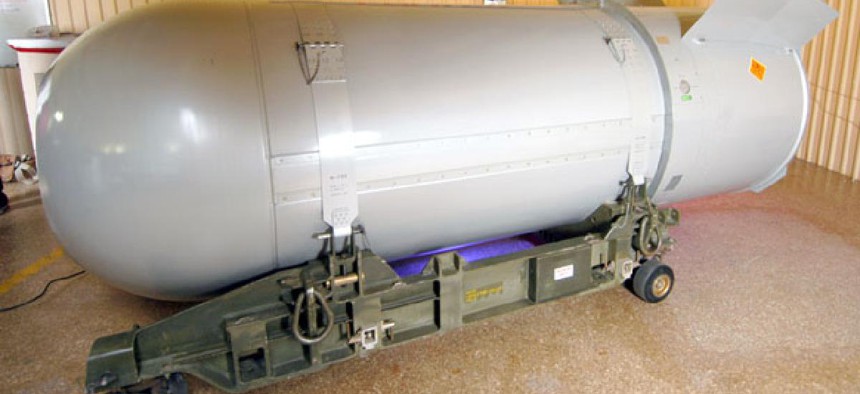
A dismantled nuclear weapon sits in a barn. AP file photo
U.S. can safely take deeper nuclear arms cuts, senior Defense official says
The Pentagon has not yet offered President Obama a recommendation on the matter.
A top Defense Department official on Wednesday said a fresh round of reductions in strategic nuclear weapons could be done without harming U.S. security, though the Pentagon has not yet offered President Obama a recommendation on the matter.
“I do believe that there are steps that we can take to further strengthen our deterrence posture and assurance of allies, and that I believe we can do so with lower numbers,” said James Miller, acting Defense undersecretary for policy.
These words constituted “a little bit of a hint,” Miller said, about how he anticipates advising Obama to proceed in sizing and shaping Washington’s nuclear arsenal in coming years.
Miller, who the White House last month nominated for the top Defense policy slot after a nearly three-year role as deputy, said Pentagon leaders have not yet concluded a “Nuclear Posture Review Implementation Study” that had previously been expected by late last year.
Begun last August, the Defense Department analysis is to survey options for carrying out policy mandates in the 2010 Nuclear Posture Review, including “measures that would strengthen deterrence, that would enhance strategic stability [and] assure our allies and partners, and that would define possible limits for future reductions below New START levels,” said Miller, speaking at a three-day symposium on nuclear deterrence in Arlington, Va.
The U.S.-Russian arms control pact entered into force in February 2011 and requires that by 2018 each side cap its deployed strategic nuclear warheads at 1,550. The agreement also limits each nation to no more than 700 fielded long-range nuclear weapon platforms -- bomber aircraft, ICBMs and submarine-launched ballistic missiles -- with another 100 permitted in reserve.
Miller would not directly address an Associated Press report published on Tuesday that said the administration was considering at least three options for further nuclear arms reductions that would slash the New START arsenal by as much as 80 percent.
Citing anonymous sources in and outside government, the AP article said that alternatives under deliberation included reductions in deployed strategic nuclear weapons to roughly 1,000 to 1,100, 700 to 800, or 300 to 400.
“We are looking at a number of options,” Miller said on Wednesday without confirming the reported details. “I will say that today’s posture and New START force levels represent one option. The status quo is the default option, and we will see if we can shift from that in a way that will strengthen deterrence, strengthen stability and strengthen assurance at lower numbers.”
The profound reductions reported to be under contemplation have already drawn kudos from some arms control advocates.
While some details of the story could not be confirmed, said Stephen Young of the Union of Concerned Scientists, “the administration is absolutely correct to look at deep cuts like this.
“The United States does not rely on nuclear weapons as a central part of our security,” he told Global Security Newswire this week. Their fundamental role in deterring a nuclear attack against Washington or its allies “can be accomplished with a far smaller stockpile than we presently maintain,” making “reductions on this scale … not only feasible, but sensible,” he said.
The idea that the Obama administration might entertain thoughts of a U.S. strategic nuclear force numbering as few as 300 warheads has also triggered outrage from some Republican lawmakers.
“Obviously this is going to create a huge stir in Congress,” Senator Jon Kyl, R-Ariz., said on Thursday in an address to the deterrence symposium. “I think we’re looking at a battle royal in the Congress if the president moves forward with these kinds of plans.”
When Miller and Air Force Gen. Kevin Chilton, then head of U.S. Strategic Command, briefed Kyl prior to the Senate's December 2010 ratification of the U.S.-Russian accord, “they made the case for the proposition that we could get by with the numbers that the New START treaty called for,” the lawmaker said. “Nobody suggested that there was a scenario under which we could go much deeper.”
In fact, prior to negotiating New START, Obama administration officials determined that the United States could accept reductions to as low as 1,300 warheads without requiring new presidential guidance, according to U.S. sources and documents. Moscow, however, was said to be unprepared to accept that deep a cut.
Reports about the Obama team eyeing more drastic reductions today could similarly prove inconsequential because Russian leaders do not share an interest in taking substantial reductions, according to a former arms control negotiator and head of the Energy Department’s nuclear security arm.
“It probably doesn’t matter because no Russian I’ve ever met has suggested any number lower than 1,000 would have any chance at all,” said Linton Brooks, speaking on Wednesday at the same forum.
He said a more viable format for future nuclear talks might involve the United States trading away some of its potential for uploading additional warheads onto existing missiles, which troubles Moscow, in exchange for limits on Russian tactical nuclear weapons, which worry Washington’s European allies.
Meanwhile, the administration’s post-NPR analysis is also assessing options for the president in case deterrence fails and the United States comes under strategic attack, Miller said. The effort is being led by the Pentagon but carried out in consultation with the Energy Department and the intelligence community, he said. Miller noted that the study has taken longer than anticipated but said it should be completed “soon.”
Some Washington insiders have called the NPR Implementation Study a “90-day” effort, “but I’ve tried to avoid that moniker,” said the Defense policy leader, explaining that he “expected at the outset” it would take longer than three months to conclude.
The 2010 posture review -- a major Pentagon assessment of nuclear strategy, forces and readiness -- cited as one of its central goals “reducing the role of U.S. nuclear weapons in U.S. security strategy.”
“Fundamental changes in the international security environment in recent years -- including the growth of unrivaled U.S. conventional military capabilities, major improvements in missile defenses, and the easing of Cold War rivalries -- enable us” to deter potential adversaries and reassure friends and partners “at significantly lower nuclear force levels and with reduced reliance on nuclear weapons,” the 2010 Nuclear Posture Review states.
In broad terms, the strategic guidance issued by the Pentagon last month for planning its fiscal 2013 and out-year budgets echoed the same theme. “It is possible that our deterrence goals can be achieved with a smaller nuclear force, which would reduce the number of nuclear weapons in our inventory as well as their role in U.S. national security strategy,” the planning guidance reads.
Miller’s comments on Wednesday morning took a small step beyond what the guidance said was “possible,” in affirming that additional reductions would indeed be desirable and no harm to strategic deterrence.
The “long-term trend” in U.S. national security strategy has been to improve conventional capabilities to such an extent that the nation now relies less on nuclear weapons than in previous decades, he said.
Under the current administration, “it’s a matter of policy and I think has very broad support in the Department of Defense,” Miller said.
He insisted, though, that Obama has “made no decisions” on seeking deeper reductions in the U.S. nuclear force, and the Pentagon “has made no recommendations” on the matter.
Asked how low he might imagine the administration would be willing to go in negotiated cuts and what might be accomplished unilaterally, Miller cited the president’s 2009 Prague speech on nuclear abolition and nonproliferation. The address in the Czech Republic is widely believed to have been the principal basis for the Nobel Peace Prize that Obama accepted later that year.
“The president has been very clear,” Miller said. “The long-term goal is the worldwide elimination of nuclear weapons. So how far can we go -- how far we get down that path -- is going to depend not just on the United States but on what other actors do.”
Given that a handful of nations are known or believed to retain relatively small nuclear arsenals -- India, Pakistan, Israel, North Korea, France and the United Kingdom -- it is “not just Russia and not just China” with whom Washington must engage if Obama’s vision is ever to be realized, he said.
Brooks said he was not holding his breath, though, for multinational negotiations on nuclear arms reductions, even if Obama wins a second term.
“Multilateral arms control will generate some more journal articles, but it is going to require a transformation of the international order that is decades away,” according to the former National Nuclear Security Administration chief. “So what’s going to happen is more U.S.-Russian arms control.”
Ellen Tauscher, a senior arms control adviser to Secretary of State Hillary Clinton, said last month that any significant movement on bilateral nuclear negotiations would likely await national elections in both the United States and Russia.
“We want to get back to the table with the Russians,” she said at a breakfast session with reporters. “We frankly need these elections to pass in order to have the conditions where both sides can make these kinds of decisions to go to the table.”
With the U.S. and Russian arsenals comprising more than 90 percent of the world’s nuclear forces, “we think that the sensible next step after New START is bilateral,” Miller said at Wednesday’s event. The next set of negotiations, in the Obama administration’s view, should “look at total nuclear weapons -- deployed, nondeployed, strategic and nonstrategic,” he said.
Full nuclear disarmament remains quite a distant goal, Brooks said.
“Abolition isn’t going to happen for at least 20 years,” said the 73-year-old former ambassador. “A careful look at actuarial tables suggests I won’t be talking to you about it when it happens.”







